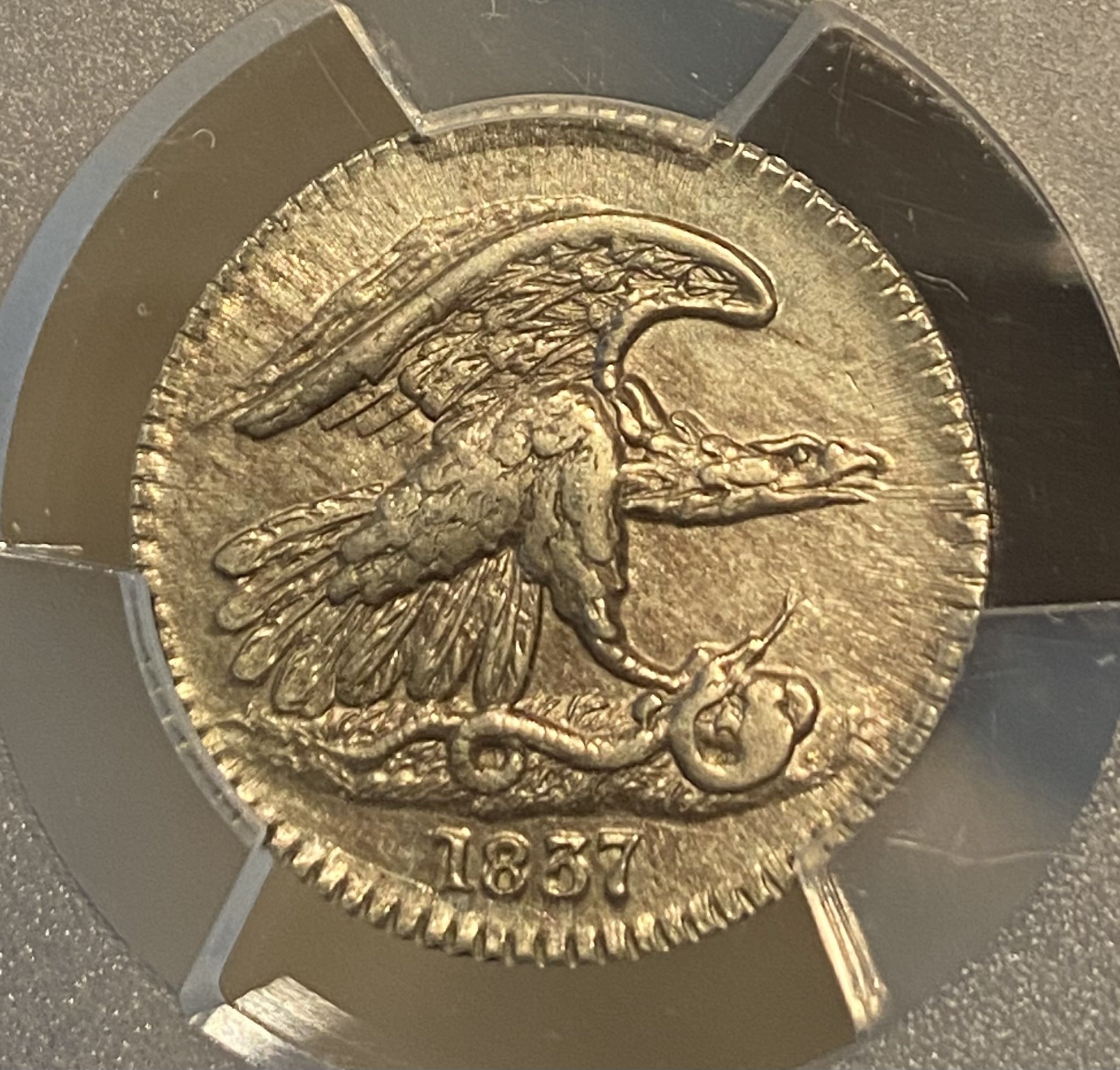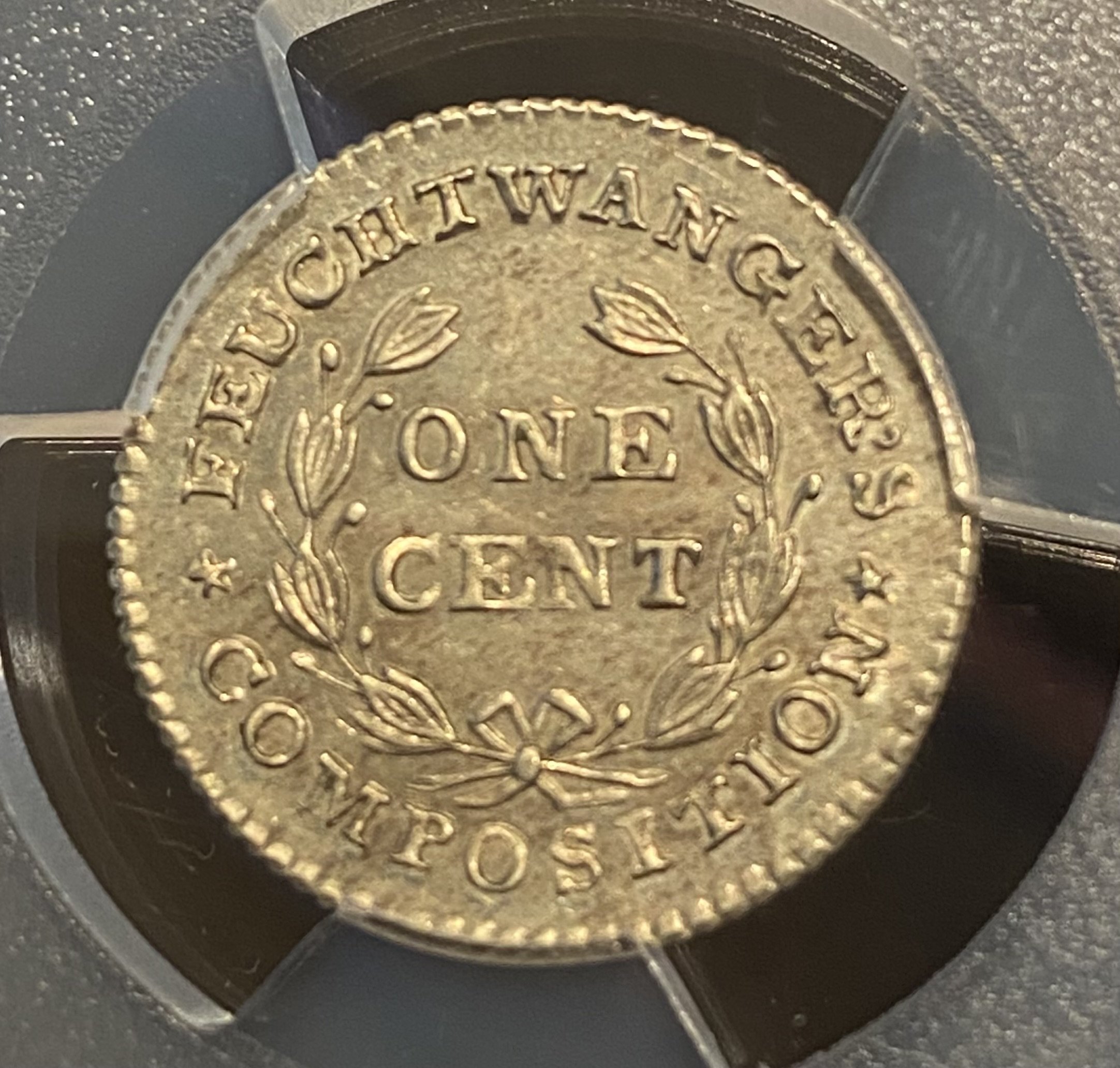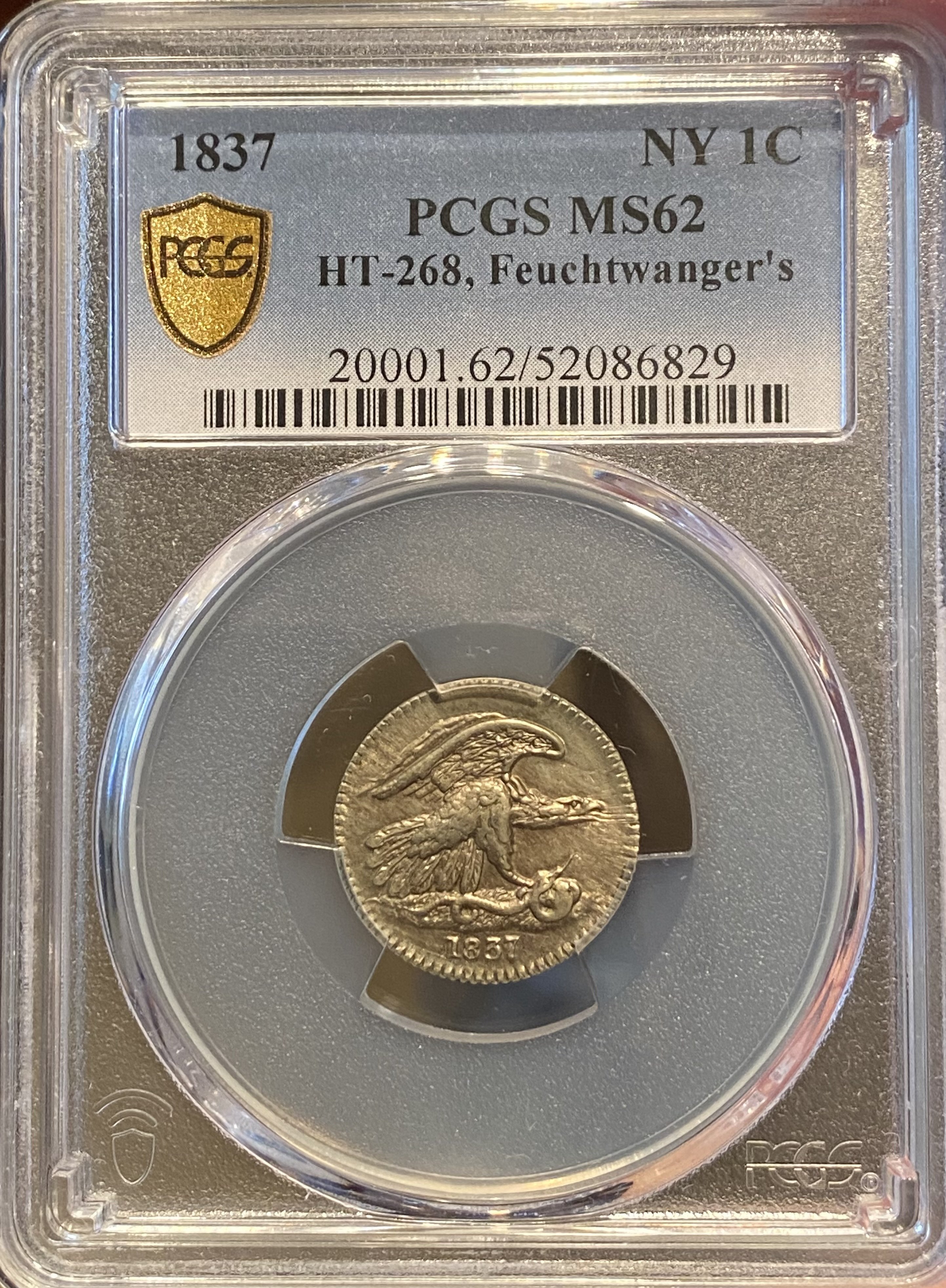Feuchtwanger’s Composition.
 jfriedm56
Posts: 2,589 ✭✭✭✭✭
jfriedm56
Posts: 2,589 ✭✭✭✭✭
I posted this new purchase in the new purchase section, asking if anyone had information on this token and no one responded. So I’m posting it here to see if anyone knows if there were different dies used or other pertinent information out there about these tokens. I do know there were 4 varieties produced. Thanks Zack.


8
Comments
Google it. They are not really obscure. There's tons of information on them, even in the Red Book.
All comments reflect the opinion of the author, even when irrefutably accurate.
https://www.novanumismatics.com/feuchtwangers-composition-cent-attribution-die-marriages-2/
All comments reflect the opinion of the author, even when irrefutably accurate.
"Obscure tokens"? As far as I know they are not obscure at all. I believe they are quite popular.
That's a nice one, by the way.
I guess obscure was the wrong term to use and I know they're in the Red Book. I was actually looking for more in depth information about different dies used and or different varieties, and posted this to find sources for better information. Thank you both and @jmlanzaf for the die marriage info as that was what I was looking for. Zack.
In the last Resources update I asked Aspie to include the NGC article. Here is the Resources link (pinned to the top of the US Forum) and it is under the 1c. Then the NGC link in the Resources thread.
https://forums.collectors.com/discussion/1006619/resources-books-links-to-read-on-numismatic-series-errors-and-varieties/p1
https://www.ngccoin.com/news/article/7628/FeuchtwangerOneCent/
https://youtube.com/watch?v=hYCRaWPlTIE Sophie Lloyd, guitar shred cover of Panama (Van Halen)
https://youtube.com/watch?v=dOV1VrDuUm4 Ted Nugent, Hibernation, Live 1976
RLJ 1958 - 2023
@jmlanzaf, just read the referenced article you sent me and that's exactly what I was looking for. Thank you so much for your sharing of knowledge. Much appreciated. Zack.
You're welcome. But I just googled it. I've always found the Feuchtelwanger coins interesting, but I don't really ibis that much about them.
All comments reflect the opinion of the author, even when irrefutably accurate.
@lilolme, thank you for all that reference material. Appreciate you. Zack.
I've questioned often why these aren't listed in pattern books as a private pattern as other privately struck pieces are.
I think these are listed in resources that also describe Hard-Times tokens.
Successful BST transactions with: SilverEagles92; Ahrensdad; Smitty; GregHansen; Lablade; Mercury10c; copperflopper; whatsup; KISHU1; scrapman1077, crispy, canadanz, smallchange, robkool, Mission16, ranshdow, ibzman350, Fallguy, Collectorcoins, SurfinxHI, jwitten, Walkerguy21D, dsessom.
The bottom berry, left or right, absent or present, answers the first 90% of what people usually want to know.
I did just notice that in one of the references I looked at. Mine has 13 berries with a single berry to the right of the bow. Looks like the G type reverse and the #6 obverse with the dash next to the upper serif of the1? So could this be a 6G -R2 as in fairly common die pair marriage?
They're definitely not obscure- I once had someone submit a hoard of over 50 of them, including 1 3-cent piece.
Yes. 6G. This is a bit scarier than the 6 I. Nice coin BTW
Here is mine, die marriage 3E. There are 15 different die marriages known according to Bowers in the HTT Red Book. There still may be undiscovered pairings.
Best, DM
Here's an article I wrote about them.
Dr. Louis Feuchtwanger’s
Coinage Proposals
By Bill Jones
Dr. Lewis Feuchtwanger was born in Fȕrth, Bavaria, Germany in 1805. His father was a metallurgist, and he developed an interest in the study of metals at an early age. Feuchtwanger graduated as a medical doctor from the University of Jena in Germany in 1827.
Seeking better opportunities, Feuchtwanger immigrated to America in 1829 and settled in New York City. There he opened a “German Pharmacy” where he sold medicines and chemicals that he imported from the German states. He sold additional items in his shop which included minerals, gems, preserved reptiles and other curiosities, which he occasionally loaned to local museums.
In the early 1830s, he had developed an alloy which he called, “Feuchtwanger’s Composition,” which was a form of German silver. One approximation of the formula for his alloy was 53% copper, 29% zinc and 19% nickel. Sometimes Feuchtwanger called his composition “American silver” to make it more attractive to local consumers and politicians. Feuchtwanger won a silver medal for his composition at the 1834 annual fair of the American Institute. He won additional medals in 1835 and 1836 for different displays, which indicated the magnitude of his interests and knowledge.
Feuchtwanger’s First Offer to the U.S. Government
In the late summer and fall of 1837, Feuchtwanger offered to license his alloy to the United States Government as a substitute for the copper large cent. In his presentations to Congress, he maintained that coins made from his alloy would be smaller, easier to carry, durable and more healthful to the population than copper cent.
Some Congressmen were interested in his proposal, but Mint Director, Robert Patterson rejected the idea. Patterson was aware that nickel had a high melting point, which posed challenges to the Philadelphia Mint’s technology at that time. It would also be difficult to analyze and work with an alloy that contained three metals. Furthermore very little nickel was produced in The United States. Much of it would have to be imported from Europe. Finally nickel is hard and brittle if it is not annealed properly. Despite that setback, the Panic of 1837, an economic depression, provided Feuchtwanger with an opportunity to put his composition to a practical test.
The Panic of 1837
The Panic of 1837 began almost as soon as the new president, Martin Van Buren, took office. There were a number of causes, but chief among them was a collapse of the price of cotton. High supplies of cotton in England resulted in low prices for U.S. exports. Many cotton producers were over extended in their investments in land and slaves. The low cotton prices left them with too much debt, and some of them defaulted on their loans. There had also been excessive speculation in western lands. When that market fell, many investors were ruined.
In addition, the Andrew Jackson administration had required that the purchases of government owned western land had to be paid for with gold and silver. That resulted in a flow of gold from the eastern banks to the west which limited the banks’ ability to issue currency. That reduced the money supply and the amount of credit that was available. Only the banks were issuing paper money. The U.S. Government was not issuing currency at that time, only coins.
The Panic also produced a shortage of small change for everyday use. To fill the gap, private businesses issued tokens which circulated in place of coins. Collectors call these pieces Hard Times Tokens (HTTs).
Hard Times Tokens
Although Hard Times Tokens were made in various sizes, most of them were similar in weight and diameter to the large cent. They were usually made of copper. Many pieces bore a resemblance to the large cent, but the issuers were careful not to violate the counterfeiting laws. Frequently the issuers used the phrase, “Millions for defense, but NOT ONE CENT for tribute.”
Unlike the other Hard Times Token users, Dr. Feuchtwanger boldly stated a value on his tokens, “ONE CENT” or “THREE CENTS.” The Feuchtwanger cent was similar in size to the modern cent. The three cent pieces were roughly the size of the modern quarter.
The Feuchtwanger Cent
The 1837 Feuchtwanger cent features a defiant eagle, facing left, grasping a snake with the date below on the obverse The reverse reads, “Feuchtwanger’s composition, ONE CENT.”
This piece is listed as HTT #268 in Russell Rulau’s Hard Times Token guide book. It is rated as a rarity 1 (R-1) variety, which is common. The mintages for all Feuchtwanger tokens are unknown, but researchers have estimated that cent mintage had to have been in the millions. Despite the fact that this piece is common, market prices for this piece are higher than they are for other R-1 HTTs because of strong collector demand.
The HTT #268 variety represents many subvarieties. Currently there are 14 minor varieties known of this design. The differences are slight. The rarities from these subvarieties range from R-1 to R-8 which represents an estimated popular of only 2 to 3 pieces. The piece shown about is a common variety.
The Feuchtwanger Three Cent Pieces
Why did Lewis Feuchtwanger issue the three cent pieces? A partial answer has been provided by numismatic author, Roger Burdette. Burdette discovered an entry in the diary of former president and then Congressman, John Quincy Adams. Adams was not in favor of replacing the large cent with the Feuchtwanger composition, but he was intrigued by the possibility of issuing a two or three cent piece.
Obviously a two or three cent piece in copper would have had to have been heavier than the large cent, which would have made the coin cumbersome to use. An alternative piece, made of Feuchtwanger’s composition, seemed like a viable alternative.
The New York State Seal Three Cent Piece
Lewis Feuchtwanger issued two types of three cent pieces in 1837. The more common type had a simplified version of New York State Seal on the obverse with the date below. The reverse features “Feuchtwanger’s Composition” around the edge with “Three Cents” in the center.
This variety has an R-3 rarity rating, which translates to “scarce.” The total number of survivors probably falls in the 400 to 500 range. Most pieces grade in the Choice VF and EF grades, but there are a fair number of well-worn examples known. Strictly Mint State pieces are scarce.
Rulau lists this piece as HTT #362 in German silver. There are a few very rare pieces known in lead and white metal.
The Defiant Eagle Three Cent Piece
Lewis Feuchtwanger’s second 1837 three cent piece features a defiant eagle, facing left, on the obverse, standing on a rocky perch with the date below. The reverse has “Feuchtwanger’s Composition, Three Cents” and fewer blooms and flourishes than the New York State Seal variety.
This variety is much scarcer than the New York State Seal piece. It is rated as an R-5 which translates to 31 to 75 pieces known. The actual number of survivors is closer to 75 examples.
The piece displayed above has a counterstamp “JMP” on the reverse. PCGS chose to label this as “damage,” but there are about 15 examples of this variety known with this mark. NGC has certified an example of this token with the counterstamp as an MS-64.
The purpose of the counterstamp has been lost to history. No one has been able to decipher who “JMP” was and why he counterstamped these pieces. If he was a silversmith, why would he have marked a piece that contained no silver? It remains a mystery.
Lewis Feuchtwanger During the Civil War
Private concerns issued large numbers of tokens during the Civil War. These pieces were most often used to replace the cent which was hoarded during the war. The vast majority of them were equal to or close to the diameter of the cent although they almost always weighed less.
Lewis Feuchtwanger issued two three cent piece designs during the Civil War era. Unlike the Hard Times Tokens he had issued previously, neither of these pieces were made for circulation. The mintages were very small, and both tokens are rare today.
The 1837 Dated Novodel Three Cent Piece
Although this piece is dated 1837, it was stuck well after that date. The obverse is similar, but subtlety different from the other 1837 dated defiant eagle three cent variety. The eagle is standing on a smaller rock, and it has fewer tail feathers. Rulau listed it as HTT #265.
The reverse, which would also be used on the following piece, reads, “Feuchtwanger’s Composition” and the value expressed twice as “3” and “Three Cents.”
This piece is an example of a novodel, which is a piece that was struck from a die that was made after the date which appears on it. The most famous novodel in United States coinage is the 1804 Silver Dollar. The first examples of those pieces were struck in 1834 although the coin is dated 1804.
Why did Lewis Feuchtwanger have a piece made with a past dated die? Perhaps he thought the “1837” date would allow him to avoid counterfeit charges if he had issued a piece with “Three Cents” on it in the late 1850s or more likely, the early 1860s.
This is the rarest of the four Feuchtwanger three cent varieties. It is rated as an R-7 (4 to 12 survivors) with probably less than 10 examples known. Most of them have Proof-Like (PL) surfaces. This special surface indicates that these pieces were made for presentation purposes, not for circulation.
The 1864 Perched Eagle Three Cent Piece
Lewis Feuchtwanger’s other Civil War era token features another eagle. This one is more tranquil with a snake held in its claws standing on an invisible perch. The date “1864” appears below. The reverse is the same as the “1837” novodel.
Despite the fact that this is a Civil War era item, Rulau listed it as HTT #267. George and Melvin Fuld listed it in their Civil War Store Card guide as NY 630-X-1j.
This token is rated as an R-6 on the Hard Times Token rarity scale, 13 to 30 pieces known. As a Civil War Token, it is also rated as an R-7, with an estimated population of 11 to 20 pieces. A more detailed estimate places the surviving total at about 20 pieces. Collectors have highly prized this Civil War Token variety for many years.
Dr. Feuchtwanger Fails to Convince Congress Once More
Despite his best efforts, Dr. Feuchtwanger was not able to get Congress to license his composition for coinage in 1864. This time his foil was American entrepreneur, Joseph Warton (1826 – 1909), who had far more friends in Congress.
Warton, had purchased a nickel mine and a refining operation in Camden, New Jersey, which is across the Delaware River from Philadelphia. Warton had a business setback when the mint removed the nickel from the Indian Cent in 1864. He quickly recovered when Congress approved of the Nickel Three Cent Piece in 1865 and the nickel five cent piece in 1866. Both of these coins contained of 75% copper and 25% nickel.
Warton enjoyed a highly successful career. He founded the Wharton School of Business at the University of Pennsylvania, and he was a co-founder of Swarthmore College in 1864. He was also a co-founder of the Bethlehem Steel Corporation in 1904.
Dr. Feuchtwanger’s Later Years
Lewis Feuchtwanger continued to operate a chemical plant that he had opened in the 1850s. It processed the commercial quantities of minerals he bought and sold into finished products that he marketed. Lewis Feuchtwanger died in 1876.
It is interesting to note that at least one of Lewis Feuchtwanger’s books is still in print. His Treatise On Gems, in Reference to Their Practical and Scientific Value, which he published in 1838, is still used by jewelers, artists, metallurgists and chemists. You author was surprised to find recent reprints of that work widely offered on the Internet.
@BillJones
Awesome article. Thanks for sharing.
@BillJones, thanks for posting such an informative article. Appreciate the effort. Zack. I learned new info today. Thanks.
I’m surprised the article doesn’t mention the Feuchtwanger store cards. Also, HT265 is a specimen strike, HT265a is a business strike, with supposedly no known examples. However I HAD an HT265a which clearly did not have a “full pressure” strike and non proof surfaces. It was miscataloged by Stacks., despite my conversation with a rep whose initials are VY. Consequently I lost about 5 grand on the sale and THAT forever drove me out of the world of high dollar numismatics.